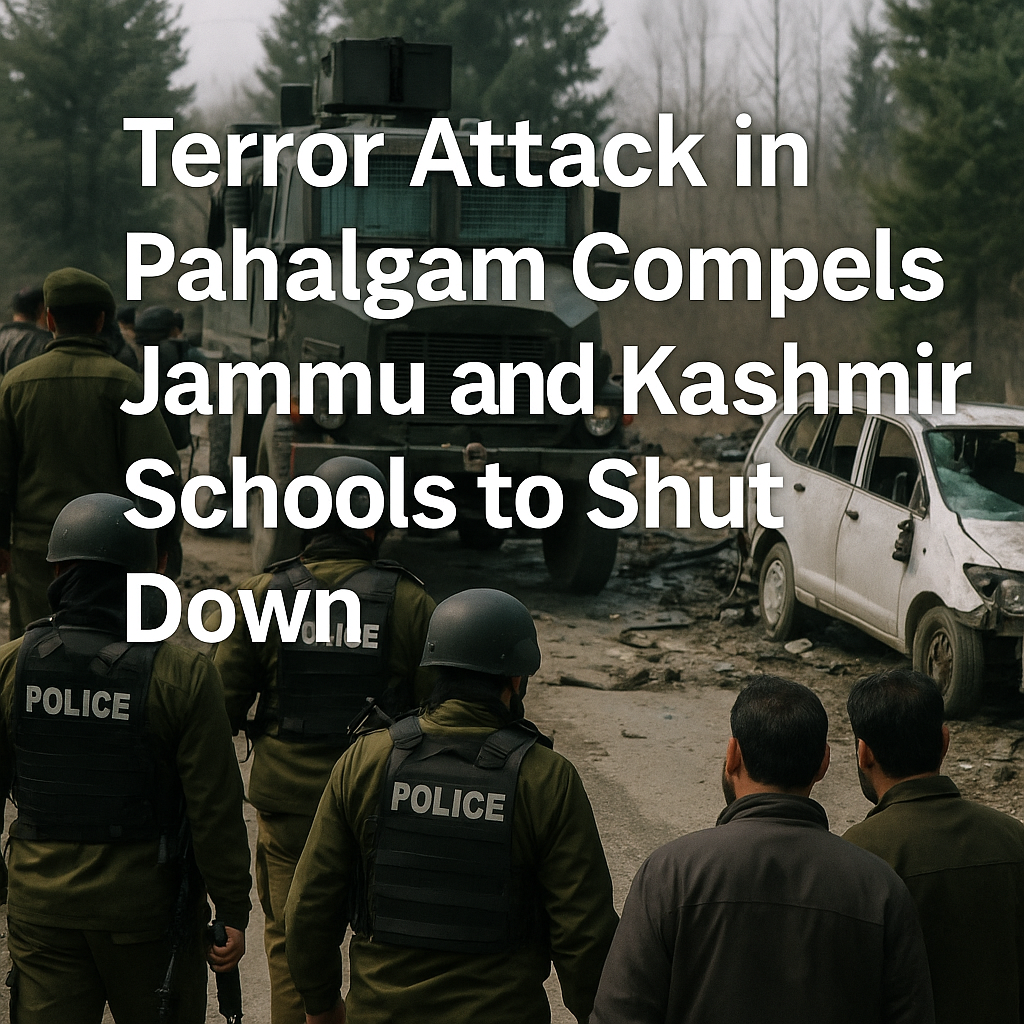Introduction
In a stark reminder of the ongoing security woes in Jammu and Kashmir (J&K), schools throughout the region were directed to be shut down after a terrorist attack was carried out in Pahalgam. The attack has again put a question mark on the safety of civilians, tourists, and schools in the valley. The attack upon security personnel has resulted in increased tensions, and the authorities reacted by taking precautionary steps, such as closing schools temporarily.
This piece discusses the specifics of the Pahalgam attack, its ramifications on education and security, how the government responded, and its wider implications on the stability of the region.
The Pahalgam Attack: What Happened?
Pahalgam, a scenic holiday resort in the Anantnag district of Jammu and Kashmir, was shaken by violence when terrorists attacked security personnel. The attack took place in the early morning hours, targeting a patrol team of the Central Reserve Police Force (CRPF) and the Jammu and Kashmir Police.
Major Facts of the Attack:
Location: The attack took place close to a security checkpoint in Pahalgam, which is a region often visited by pilgrims and tourists.
Casualties: Though the official figures of the wounded or killed have not been revealed, reports state that several security personnel were wounded during the crossfire.
Terrorist Outfit Involved: No outfit has publicly taken responsibility so far, but the officials suspect the hand of Lashkar-e-Taiba (LeT) or Jaish-e-Mohammed (JeM), groups infamous for such attacks in the area.
The attack has prompted a largescale search operation in the area around it, with more forces being deployed to catch the culprits.
Why Were Schools Closed Following the Attack?
Following the attack, the Jammu and Kashmir administration issued an advisory directing all regional schools to remain closed as a precautionary measure. The decision was influenced by several factors:
1. Immediate Security Threat
Authorities feared that terrorists might target crowded places, including schools, to create panic.
Intelligence inputs suggested the possible movement of militants in nearby areas.
2. Preventing Civilian Casualties
With increased military movement and potential clashes, having children stay home minimized the risk of collateral damage.
Teachers and parents worried about student safety in the face of escalating tensions.
3. Past Precedents
J&K has seen a number of incidents where schools have been targeted or become caught in the crossfire.
The administration did not wish to risk it, particularly after a direct assault on security personnel.
Impact on Education in Jammu and Kashmir
The frequent shutdown of schools because of security concerns has long-term effects on the education system in Jammu and Kashmir.
1. Disruption of Academic Calendar
Repeated shutdowns result in loss of instructional days, impacting exam schedules.
Students in far-flung areas, where digital education is not available, are most affected.
2. Psychological Impact on Students
Recurring exposure to violence and uncertainty instills fear and anxiety in children.
Most students experience post-traumatic stress disorder (PTSD) as a result of such incidents.
3. Reduction in School Attendance
Parents fear for the safety of their children and, thus, do not send them to school following such attacks.
Dropout rates rise, especially among females, as families value security above education.
4. Difficulty for Teachers
Teachers are hindered from ensuring continuity of classes.
Most teachers also do not feel secure traveling to schools located in violent neighborhoods.
Government and Security Forces’ Response
The Pahalgam attack has evoked a multi-level reaction from both the state and central governments.
1. Increased Security Measures
More CRPF and army units have been deployed in vulnerable areas.
Random stops and searches of vehicles have been increased.
2. Intelligence Gathering
Security agencies are trying to track the movement of the attackers and their support system.
Local informants and technical surveillance are being employed to monitor militant activity.
3. Political Reactions
Party leaders, irrespective of parties, denounced the attack and asked for more intense counter-terrorism steps.
The Lieutenant Governor of J&K conducted an emergency meeting to discuss the security situation.
4. Long-Term Counter-Insurgency Strategies
The government is making efforts towards dismantling the hideouts of terrorists in the Kashmir Valley.
Efforts against cross-border infiltration are being geared up.
Greater Implications for Jammu and Kashmir
The Pahalgam attack is not isolated but a part of a bigger trend of violence in the region. Its implications go beyond the near-term security issues.
1. Implication for Tourism
Pahalgam is a significant tourist destination; such attacks frighten tourists, and the local economy is affected.
Hoteliers, guides, and small entrepreneurs lose money because of cancellations.
2. Civilians’ Trust Deficit
Locals get caught in between militants and security personnel, and as a result, there is mistrust.
Civilian casualties during counter-terror operations further estrange the populace.
3. Geopolitical Implications
The attack has the potential to increase tensions between India and Pakistan, with cross-border terrorism charges.
International institutions can issue travel warnings, influencing foreign investments.
Way Forward: Ensuring Security and Normalcy
Though emergency steps have been taken to safeguard the area, long-term remedies are needed so that such acts do not take place in the future.
1. Improving Intelligence Networks
Improved coordination among central and state agencies to avert attacks.
Employment of sophisticated surveillance technology to track suspected activities.
2. Community Engagement
Establishing trust among local communities to obtain actionable intelligence.
Youth rehabilitation programs to counter the risk of radicalization.
3. Securing Educational Institutions
Deployment of armed security in schools in high-risk zones.
Training teachers and students in emergency response procedures.
4. Economic Development Initiatives
Employment generation to counter youth militancy.
Promoting tourism through improved security guarantees.
Conclusion
The attack on Pahalgam and the subsequent closure of schools emphasize the tenuous security environment of Jammu and Kashmir. Even as the government and security establishment are acting against threats, what is required to ensure lasting peace is a persistent effort with a combination of intelligence, cooperation at the local level, and economic development.
Education, which is the cornerstone of an advanced society, must be protected at any cost. The frequent disruption of school-going only impedes the learning process but also sends the young minds deeper into the psychological dents. It is the responsibility of all concerned—security forces, policymakers, teachers, and civilians alike—to join hands to ensure that incidents like these do not sidetrack the destiny of the children in Jammu and Kashmir.
As the region struggles to come to terms with this latest episode of violence, the hope is that stability will return soon, with schools reopening and life able to return to its usual trajectory. In the meantime, the focus has to be on the safety and well-being of each inhabitant of this war-torn paradise.






